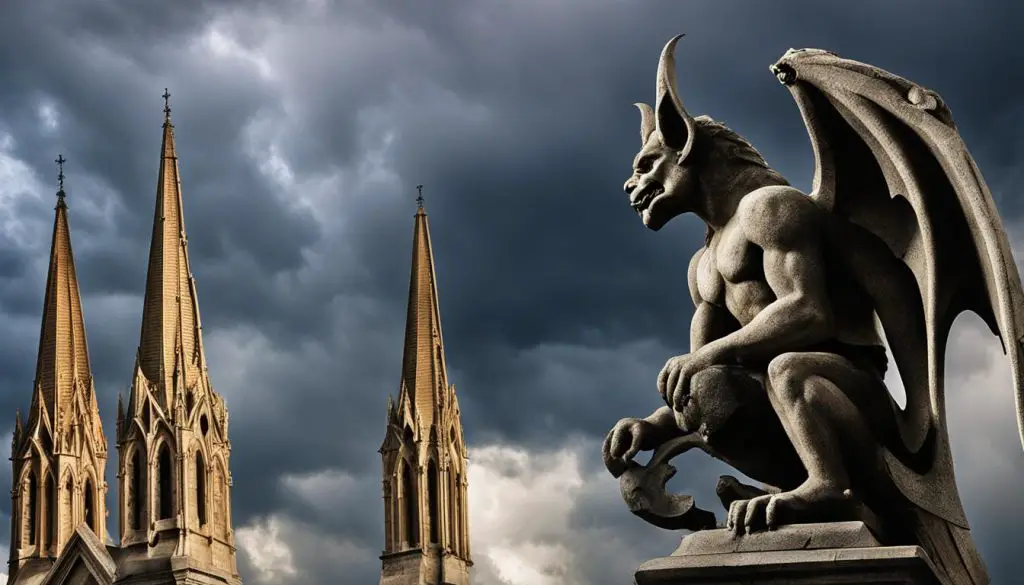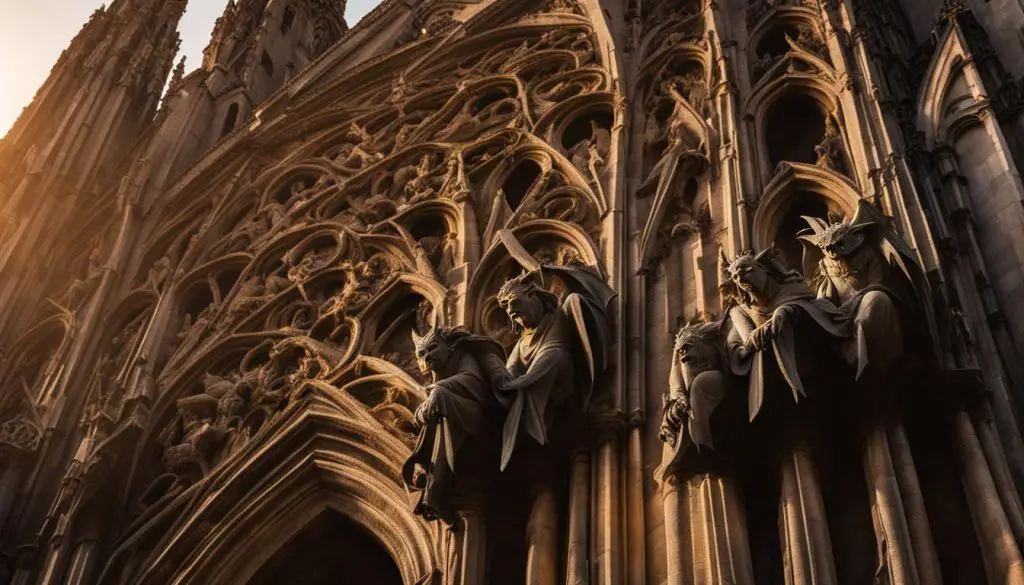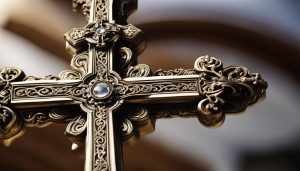Gargoyles have long been associated with religious architecture, particularly in medieval Christian buildings. Some believe that they were meant to ward off evil spirits and protect the church and its occupants. The name “gargoyle” comes from the French word “gargouille,” which means gullet or throat, referring to the sound of water gurgling from the creature’s mouth. While the Bible does not specifically mention gargoyles, there are interpretations and symbolism associated with them in Christianity.
Contents
- 1 The Legend of Gargoyles
- 2 The Purpose of Gargoyles in Christian Architecture
- 3 Symbolism of Gargoyles in Christianity
- 4 Controversy and Interpretations of Gargoyles in Christianity
- 5 Gargoyles as Mythical Guardians
- 6 Gargoyles and the Afterlife
- 7 Conclusion
- 8 FAQ
- 8.1 Are gargoyles mentioned in the Bible?
- 8.2 What is the legend behind gargoyles?
- 8.3 What was the purpose of gargoyles in Christian architecture?
- 8.4 What is the symbolism of gargoyles in Christianity?
- 8.5 Why is there controversy surrounding gargoyles in Christianity?
- 8.6 Do gargoyles protect against evil spirits?
- 8.7 What is the relationship between gargoyles and the afterlife?
- 9 Source Links
Key Takeaways:
- Gargoyles are often found in medieval Christian buildings as symbols of protection against evil.
- The name “gargoyle” comes from the French word “gargouille” which means gullet or throat.
- While the Bible does not mention gargoyles explicitly, they hold symbolic significance in Christianity.
- Gargoyles can represent the battle between good and evil, as well as serve as protectors of the church.
- Interpretations of gargoyles vary and depend on individual and cultural beliefs.
The Legend of Gargoyles
The origins of gargoyles can be traced back to an intriguing legend known as the tale of La Gargouille. According to the story, a fearsome dragon named La Gargouille terrorized the town of Rouen in France, causing destruction and instilling fear in the hearts of the townspeople. In their desperation, the people sought the help of St. Romanus, a courageous and revered figure.
St. Romanus devised a clever plan to defeat the dragon by using a condemned prisoner as bait. He managed to lure La Gargouille out of the river and subdue the creature, ultimately saving the town from further devastation. In a symbolic gesture, the head of the defeated dragon was mounted on the town’s cathedral as a warning to evil spirits.
“The tale of La Gargouille serves as the foundation for the presence of gargoyles in Christian architecture, as they became a powerful symbol of protection against evil spirits,” says Professor Amelia Jones, an expert in medieval folklore.
This legend not only explains the origin of gargoyles but also highlights their mythical significance. Gargoyles, with their grotesque appearances, came to be associated with warding off evil spirits and safeguarding churches and their occupants from malevolent forces.
| Legend of Gargoyles | Symbolism | Interpretation |
|---|---|---|
| The defeat of the dragon La Gargouille by St. Romanus | Protection against evil | Gargoyles as guardians of the church |
| Mounting the dragon’s head on the cathedral | Warning to evil spirits | Gargoyles as deterrents to malevolence |
The legend of La Gargouille continues to be an important part of gargoyle mythology, underscoring their role as mythical guardians and protectors against evil spirits.
The Purpose of Gargoyles in Christian Architecture
Gargoyles served a dual purpose in Christian architecture, both practical and symbolic. On a functional level, these grotesque creatures were strategically placed as rain spouts, ensuring the efficient diversion of water away from the roof and walls of the building. Their architectural design contributed to the preservation of the structure by preventing erosion caused by water damage.
But beyond their utilitarian function, gargoyles held deep symbolism in Christian belief. The monstrous and intimidating appearance of gargoyles was thought to ward off evil spirits and protect the church and its occupants from spiritual harm. Their presence served as a visual reminder of the ongoing battle between good and evil, emphasizing the need for spiritual protection and vigilance.
“The gargoyles, with their fierce countenances, were not mere decorative features but represented the eternal struggle against sin and the forces of darkness,” explains renowned art historian Dr. Elizabeth Parker.
They were believed to possess a mystical power that acted as a barrier against malevolent forces. Gargoyles were seen as guardians, standing sentinel at the boundaries between the sacred and profane, serving as physical representations of the spiritual protection afforded by the Church.
Table: The Symbolic and Functional Aspects of Gargoyles in Christian Architecture
| Aspect | Function | Symbolism |
|---|---|---|
| Rain Spouts | Redirect water away from the building | Protection against physical decay |
| Guardians | Defend against evil spirits | Protection against spiritual harm |
| Symbolic Reminder | N/A | The battle between good and evil |
The purpose and symbolism of gargoyles in Christian architecture remain a subject of fascination and interpretation. From their practical function as water diverters to their powerful representation of spiritual protection, these creatures continue to intrigue and inspire contemplation today.
Symbolism of Gargoyles in Christianity
While the Bible does not explicitly mention gargoyles, they have come to hold symbolic significance in Christianity. Gargoyles are often seen as representations of the battle between good and evil, serving as reminders of the inherent sin and evil in the world. Their grotesque appearance and menacing presence can be interpreted as a physical manifestation of the spiritual battle against sin and evil.
Furthermore, gargoyles are considered protectors in Christian architecture. They are believed to guard the church and its occupants from spiritual harm, acting as a deterrent to evil spirits. In this sense, they symbolize the need for protection and purification, reinforcing the idea of living a righteous and virtuous life.
It is important to note that interpretations of gargoyles can vary among individuals and cultures. Some may view them as purely decorative elements, while others see them as moral reminders or representations of cultural history. Ultimately, the symbolism of gargoyles in Christianity depends on one’s personal interpretation and beliefs.

Gargoyles in Christian Symbolism
“Gargoyles are physical representations of the spiritual battle between good and evil. Their presence reminds us of the constant struggle against sin and the need for spiritual protection and purification.” – Christian Theologian
Despite the controversy and varying interpretations, one cannot deny the visual impact of gargoyles in Christian architecture. Their unique and often awe-inspiring designs serve as a testament to the creativity and craftsmanship of the artists who carved them. Whether viewed as symbolic guardians or reminders of our own human flaws, gargoyles continue to fascinate and intrigue both believers and non-believers alike.
| Gargoyle Interpretation | Meaning |
|---|---|
| Battle Between Good and Evil | Gargoyles represent the ongoing struggle against sin and evil in the world. |
| Protection and Purification | They serve as guardians, protecting the church and its occupants from spiritual harm. |
| Decorative Elements | Gargoyles can also be appreciated for their artistic and architectural value. |
| Moral Reminders | Some interpret gargoyles as reminders of the consequences of sin and the need for redemption. |
Controversy and Interpretations of Gargoyles in Christianity
The use of gargoyles in Christian architecture has sparked debate and controversy throughout history. It is interesting to examine the various religious beliefs and interpretations surrounding these intriguing creatures. Some argue that the inclusion of gargoyles in church design reflects the unique cultural history of the community in which the cathedral is located. These individuals believe that the pagan influences on the architecture serve as a testament to the blending of different belief systems and the evolution of religious practices.
On the other hand, some view gargoyles as moral lessons. The grotesque and often demonic appearance of these creatures is thought to serve as a reminder of the constant presence of sin and the need for redemption. From this perspective, the inclusion of gargoyles in Christian architecture is a way to visually represent the theological belief in the consequences of one’s choices and the eternal struggle between good and evil.
“The use of gargoyles is a contentious topic, with various interpretations and opinions. Some see them as remnants of a bygone era, while others appreciate their cultural and historical significance.” – Dr. Elizabeth Monroe, Professor of Religious Studies
The interpretation of gargoyles in Christianity is subjective and can vary across different individuals and cultures. While some may dismiss their significance as mere decorative elements, others find deeper meaning in their presence. Ultimately, the interpretation of gargoyles in the context of religious beliefs is a personal and subjective matter, open to a wide range of interpretations.
| Religious Beliefs | Pagan Influences | Moral Lessons | Cultural History |
|---|---|---|---|
| Some see gargoyles as symbolic representations of religious beliefs. | Gargoyles are believed to have been influenced by pagan imagery. | Gargoyles serve as reminders of the presence of sin and the need for redemption. | The inclusion of gargoyles reflects the cultural history of the community in which the cathedral is located. |
| Others find no specific religious significance in gargoyles. | They view gargoyles as purely decorative elements. | Gargoyles are seen as embodiments of moral lessons. | Gargoyles represent the blending of different belief systems and the evolution of religious practices. |
Gargoyles as Mythical Guardians
When it comes to gargoyles in Christian architecture, they are often seen as more than just decorative elements. Many believe that these fantastical creatures serve as mythical guardians, protecting the church and its occupants from evil spirits. The demonic symbolism and grotesque appearance of gargoyles are believed to scare away these malevolent forces, acting as a physical deterrent to their presence.
Throughout history, gargoyles have been thought to possess a spiritual and protective role. They are seen as defenders against spiritual harm, reinforcing their association with the timeless battle against evil. With their watchful presence, gargoyles stand as a reminder of the constant need for protection and vigilance against the forces of darkness.
“Gargoyles are like sentinels, standing guard against evil. They represent our ongoing fight against the forces that seek to harm us spiritually,” says Reverend Lawrence Thompson, a prominent theologian.
The prominence of gargoyles as guardians can be observed in their strategic placement on the exterior of churches and cathedrals. Perched high above, they survey the surroundings, ever watchful for any sign of impending danger. Their imposing presence and intimidating figures serve as a visual representation of the ongoing struggle between good and evil.

Guardians in Artistic Detail
When examining the intricate details of gargoyles, one can also uncover their symbolic significance as guardians. The craftsmanship of these creatures showcases both the creativity and craftsmanship of the artists who brought them to life. The exaggerated features, such as sharp claws, fierce expressions, and leering tongues, further enhance their role as protectors against evil.
A closer look at gargoyles reveals the level of thought and intention behind their design. Different types of gargoyles represent various aspects of protection and guardianship. Some gargoyles depict angels, symbolizing divine intervention and spiritual guidance. Others take on the form of mythical beasts, highlighting their role as defenders against malevolent forces.
| Gargoyle Type | Symbolism |
|---|---|
| Angel Gargoyle | Divine protection and guidance |
| Grotesque Gargoyle | Fear-inducing deterrent against evil |
| Animal Gargoyle | Mystical defenders |
These diverse representations demonstrate the multifaceted nature of gargoyles as guardians, providing a layered interpretation of their significance in Christian architecture. Their presence not only adds character and aesthetic appeal to buildings but also serves as a constant reminder of the ongoing battle against evil forces and the need for spiritual protection.
Gargoyles and the Afterlife
While the Bible does not specifically mention gargoyles, it contains references to damnation and the existence of evil. These biblical references have led to various interpretations of the symbolism behind the presence of grotesque and demonic imagery in Christian architecture, including gargoyles. Some interpret their presence as a reflection of the consequences of sin and the possibility of a damned afterlife.
The concept of damnation in the Bible is closely tied to the idea of hell, a place of eternal punishment for sinners. Gargoyles, with their fearsome appearance, are often associated with demonic and sinful imagery. Their presence in Christian architecture can be seen as a visual reminder of the consequences of one’s choices and the eternal struggle between good and evil.
“And if thy hand offend thee, cut it off: it is better for thee to enter into life maimed, than having two hands to go into hell, into the fire that never shall be quenched: Where their worm dieth not, and the fire is not quenched.” – Mark 9:43-44
While interpretations may vary, the inclusion of gargoyles in Christian architecture serves as a reminder of the spiritual battle against sin and evil. It prompts contemplation about the eternal consequences of one’s actions and the need for redemption.
| Biblical References | Keywords |
|---|---|
| Mark 9:43-44 | hand offend, enter into life maimed, go into hell, fire, worm dieth not |
| Matthew 10:28 | fear him which is able to destroy both soul and body in hell |
| Revelation 21:8 | sorcerers, idolaters, liars, their part in the lake which burneth with fire and brimstone |
Conclusion
The perspective on gargoyles and their symbolism in Christianity is shaped by individual religious beliefs and interpretations. While the Bible does not provide explicit guidance on gargoyles, many believers find meaning in their presence within Christian architecture.
For some, gargoyles symbolize the ongoing battle between good and evil, serving as reminders of the constant struggle against sin. They are seen as protectors and defenders against evil forces, guarding the church and its occupants.
Others view gargoyles as decorative elements without specific religious significance. They appreciate their unique and intricate designs, adding character to religious buildings.
In the end, whether you view gargoyles as symbols of sin, defenders against evil, or simply visually appealing elements, their presence in religious architecture continues to provoke contemplation and inspire discussion about faith and spirituality.
FAQ
Are gargoyles mentioned in the Bible?
While the Bible does not specifically mention gargoyles, there are interpretations and symbolism associated with them in Christianity.
What is the legend behind gargoyles?
According to legend, a fearsome dragon known as La Gargouille terrorized the town of Rouen in France. The dragon was eventually defeated by St. Romanus, and its head was mounted on the town’s cathedral as a warning to evil spirits.
What was the purpose of gargoyles in Christian architecture?
Gargoyles served both practical and symbolic purposes. They acted as rain spouts, diverting water away from the roof, and were believed to protect the church and its occupants from evil spirits.
What is the symbolism of gargoyles in Christianity?
Gargoyles can be seen as representations of the battle between good and evil. They serve as reminders of the presence of sin and evil in the world, while also symbolizing protection and guarding against spiritual harm.
Why is there controversy surrounding gargoyles in Christianity?
The use of gargoyles in Christian architecture has sparked debate over the inclusion of pagan-inspired creatures and their moral lessons. Interpretations vary based on individual and cultural beliefs.
Do gargoyles protect against evil spirits?
Yes, many believe that the grotesque appearance of gargoyles scares away demonic forces, serving as a physical deterrent to their presence. They are seen as mythical guardians protecting the church and its occupants.
What is the relationship between gargoyles and the afterlife?
While the Bible does not mention gargoyles specifically, the presence of grotesque and demonic imagery in Christian architecture reflects the consequences of sin and the eternal struggle between good and evil.






